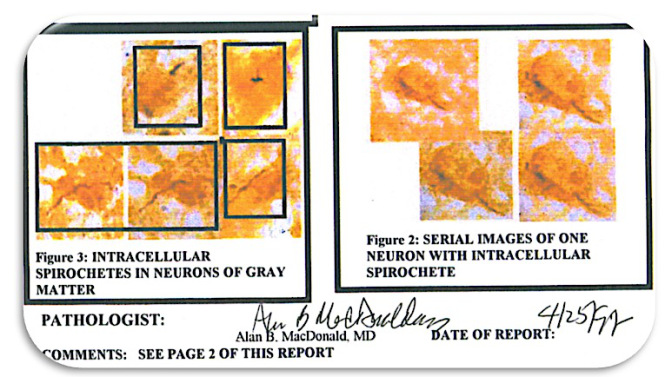The Seven Provocative Findings of the Dr. Paul Duray
- Mother-to-child transmission of Borrelia across the womb
- Finding Borrelia burgdorferi and miyamotoi associated with Amyloid Plaques in Alzheimer’s disease brains
- Finding Borrelia in Lewy Body Dementia
- Nematode worms found in the CSF (spinal fluid) of Multiple Sclerosis patients
- Nematode worms found in Alzheimer’s brains
- Borrelia found in five deadly brain tumors (Glioblastoma multiforme)
- Borrelia Mayonii and Borrelia burgdorferi found in human testicle
Since 1975 when Lyme disease was first introduced to the medical literature, it has been surrounded by controversy and misunderstandings. Much of the problem stemmed from trying to understand this disease entirely through antibody tests (serology) based entirely on just one species – Borrelia burgdorferi.
We now know that there are many species of Lyme disease. Borreliosis is not just one disease, it is part of a family of diseases that can no longer be considered separate or isolated from Lyme disease. The best example of this is Borrelia miyamotoi. It is found in hard-shelled ticks just like Lyme disease, but it is a Relapsing Fever borrelia. It took over 10 years for microbiologists to place it in the Relapsing Fever category as opposed to the Lyme-genetic grouping.
Not surprising is the fact that B. miyamotoi is found in the human brain right alongside B. burgdorferi. They may look like two separate diseases on paper, but in the human brain they are pathogens and must be eradicated together.
An even more concerning part of the Lyme disease story is that virtually no funding in any country has been put into Borrelia pathology. The fact is Lyme serology simply cannot detect this family of bacteria with any reliability, mostly because Borrelia, once inside the human brain, is behind the blood-brain-barrier, and inside human brain cells. As a result, the human immune system can no longer recognize it.
Add to this the fact there are more than a dozen species of Borrelia that cause Lyme disease, many of which can penetrate any tissue, and add a couple Relapsing Fevers that tag along for the ride, and it becomes clear that the Lyme disease blood tests based on Borrelia burgdorferidetection that have been used for 30 + years have become pretty much useless.
I first met Dr. Alan MacDonald and Dr. Paul Duray in 1992, and I was excited because they were doing the kind of research that I thought was beneficial, focusing directly on the disease process. Their pathology-based research got to the heart of it. In a sea of endless tick and deer studies, pathology seemed to me the best way to understand this disease.
I met Dr. Paul Duray through two friends of mine. Barb Jones RN had been attending Lyme conferences for years because her elderly mother and her husband had severe Lyme disease, and I was a Lyme patient barely able to walk, stand or remain awake. At Lyme Disease conferences, we often spoke with Dr. Duray’s lab assistant Amy Jones and got the inside story.
When Barb’s mother died in 1994 I arranged for Dr. Paul Duray to do a brain autopsy to look for Lyme disease. Barb put $2,000 of the estate towards the cost of the research, but Dr. Duray was between jobs and institutions and to cut a long story short, the Fox Chase Cancer Center kept the money and lost the brain. I was devastated. It took over a year for them to realize they had no clue as to the location of an 87 year-old’s formalin-soaked brain!
Then in 1997 we had another opportunity to do brain Lyme research.
I had worked with three sons who had all been disabled from Lyme disease. They all made noticeable recoveries while on antibiotic therapy. The boys’ father was in a nursing home with Alzheimer’s dementia. When the family learned that their father was just a few days from dying, the oldest son wanted to do a brain autopsy to see if their father had Lyme disease just like his brothers and himself.
They all grew up on the same farm, as hunters, farmers and loggers, so their exposure to ticks was nine months a year in an area that was highly Lyme-endemic.
I urged Jim Forris to contact Dr. Alan MacDonald to do a brain autopsy. The results were stunning, confirming my suspicions and beliefs. Borrelia entered the brain and most probably caused dementia just like syphilis.
In 1997 Alan MacDonald was the first to prove by this brain-autopsy, that the Lyme bacteria not only entered the brain, but that the spirochetes penetrated neurons (nerve cells) and survived intracellularly inside human brain neurons.
This one brain-autopsy proved that Borrelia entered the brain and the spirochetes penetrated brain cells!
To read the complete article click here


Write a Comment